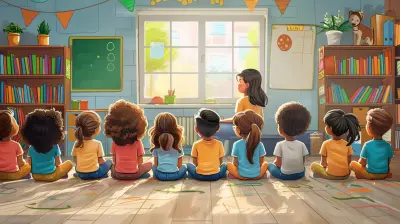23 February 2025
In today's world, financial literacy is an essential skill that often goes overlooked in traditional education systems. It’s a topic that can shape your child's future in more ways than one. But here’s the good news: if you're homeschooling your kids, you have the perfect opportunity to teach them the ins and outs of managing money. You can make learning about finances not just educational but also fun and engaging.
In this article, we’re going to explore why teaching financial literacy in your homeschool is crucial, how to go about it, and practical tips that will help your child understand money management like a pro. So, whether you’re a homeschooling veteran or just getting started, let’s dive into the world of financial literacy!

Why Financial Literacy Is Important for Kids
Let’s start with the basics—why does financial literacy matter? You might be thinking, “My child is still young. Do they really need to start learning about finances now?” The answer is a resounding yes!Think about it: money plays a significant role in our daily lives, from buying groceries to paying bills, investing, and even saving for the future. Yet, many adults struggle with financial planning, budgeting, and saving because they weren't taught these skills early on. This is where you, as a homeschooling parent, come in.
Teaching financial literacy helps your child:
- Understand the value of money: Knowing how money works helps children appreciate it more and avoid reckless spending.
- Make informed decisions: They’ll learn to weigh the pros and cons before making purchases, knowing that every financial decision has consequences.
- Develop budgeting skills: When kids learn to budget early, they’re more likely to manage their finances better as adults.
- Avoid debt: Financial literacy teaches the importance of living within one’s means and understanding the difference between good debt (like a mortgage) and bad debt (like credit card debt).
- Build wealth over time: By learning about saving, investing, and compound interest, your child can start building a solid financial foundation from a young age.
In short, teaching financial literacy gives your child the tools they need to become financially independent and responsible adults. Isn’t that what we all want for our kids?

When Should You Start Teaching Financial Literacy?
You might be wondering: when is the right time to start teaching financial literacy? Surprisingly, the earlier, the better.You can introduce basic money concepts as soon as your child starts showing an understanding of numbers. For instance, preschoolers can grasp the idea of exchanging money for goods. Elementary-aged children can start learning about saving, while middle and high schoolers can dive into more complex topics like budgeting, investing, and credit.
Remember, financial literacy isn’t something you teach in one sitting. It’s an ongoing process that evolves as your child grows. The key is to tailor your approach based on their age and understanding.

Starting with the Basics: Introducing Money to Young Kids
If your homeschooler is still young, don’t worry—you can still teach them valuable financial lessons. Start small and make it relatable. Here are some simple ways to introduce financial concepts to young children:1. Play Store
Set up a pretend store in your home. Give your child play money and let them “buy” items from the store. This activity teaches them the concept of exchanging money for goods and services. Plus, it's a ton of fun!2. Piggy Banks
Get your child a piggy bank and encourage them to save a portion of any money they receive, whether it’s from allowances, gifts, or doing small chores. This helps instill the habit of saving from an early age.3. Counting Coins
Introduce your child to different coins and bills, teaching them how to count money. You can turn this into a math lesson by showing them how to add and subtract using real or play money.4. Basic Needs vs. Wants
Teach your child the importance of distinguishing between needs and wants. You can do this by explaining that while we need food and shelter, toys and candy are wants. This simple distinction helps them prioritize their spending as they grow older.
Building on the Basics: Financial Literacy for Older Kids
As your child gets older, you can introduce more advanced financial concepts. Here’s how you can build on their early understanding of money:1. Allowances and Budgets
One of the best ways to teach kids about money management is by giving them an allowance. But here’s the catch—don’t just hand it over. Encourage them to create a budget. This can be a simple exercise where they allocate a portion for savings, a portion for spending, and maybe even a portion for charity.You can also introduce the concept of “paying” for their entertainment. For example, if they want to buy a new video game, they need to save for it. This teaches them about delayed gratification and the importance of saving for big-ticket items.
2. Setting Financial Goals
Help your child set short-term and long-term financial goals. For example, they might want to save up for a new toy or a trip. Having a tangible goal in sight makes saving more rewarding. You can even match their savings to encourage them further—think of it as a “parent match” similar to how employers match 401(k) contributions.3. The Power of Compound Interest
If you want to blow your middle schooler’s mind, teach them about compound interest. Explain how money can grow over time when it's invested or saved in an interest-bearing account. Use real-world examples or online calculators to show them how even small amounts can grow significantly over time.This lesson is a game-changer because it introduces the concept of investing. You can explain how people invest in stocks, bonds, and other assets to grow their wealth over time.
4. Understanding Credit and Debt
By the time your child reaches high school, it’s essential to start talking about credit and debt. Explain how credit works, the importance of maintaining a good credit score, and the dangers of high-interest debt like credit cards.Let them know that not all debt is bad—some types of debt, like student loans or mortgages, can be beneficial if managed wisely. However, it’s crucial to understand the terms and conditions before taking on any debt.
Real-World Financial Lessons You Can Teach in Your Homeschool
One of the best things about homeschooling is that you have the flexibility to incorporate real-world lessons into your curriculum. When it comes to financial literacy, there are plenty of opportunities to teach your child practical skills. Here are a few ideas:1. Involve Them in Household Budgeting
Why not make budgeting a family affair? Sit down with your child and go over the household budget. Show them how much money comes in, how much goes out, and how important it is to allocate money for bills, savings, and discretionary spending. This gives them a real-world understanding of how to manage money and prioritize expenses.2. Teach Them About Bills
Show your child a few of your household bills—like electricity, water, or internet—and explain how they’re calculated. You can even involve them in reducing these bills by teaching them about energy-saving habits. This not only helps with financial literacy but also promotes responsibility.3. Introduce Them to Shopping Smart
The next time you go grocery shopping, take your child along. Show them how to compare prices, look for discounts, and stick to a shopping list. You can even give them a small budget and let them pick out a few items. This teaches them the value of making informed decisions and avoiding impulse purchases.4. Open a Savings Account
Consider opening a savings account for your child. Many banks offer accounts specifically designed for kids. Let them deposit a portion of their allowance or birthday money and watch their savings grow. This hands-on experience helps them understand how banks work and the benefits of saving money.5. Create a Mini Investment Portfolio
If your child is ready, you can introduce them to investing. Start small—maybe with a few shares of stock or a low-risk investment. This can be a fun and educational project where you track the investment over time and discuss the ups and downs of the market.Fun Resources and Activities for Teaching Financial Literacy
Who says learning about money has to be boring? There are plenty of fun resources and activities that make financial literacy an exciting subject for homeschoolers.1. Educational Games
There are several board games and online games that teach financial literacy. Classics like Monopoly or newer games like The Game of Life are great for teaching kids about money management, investing, and decision-making.2. Books on Financial Literacy
There are plenty of books out there that explain money concepts in a kid-friendly way. For younger kids, books like “Money Plan” by Monica Eaton can be a great start. For older kids, “Rich Dad, Poor Dad for Teens” by Robert Kiyosaki is a fantastic resource.3. Apps for Financial Learning
There are also financial apps designed for kids and teens. Apps like PiggyBot and Bankaroo allow kids to manage virtual allowances and savings, giving them practical experience in budgeting and saving.Conclusion: Financial Literacy is a Lifelong Skill
Teaching financial literacy in your homeschool is one of the best gifts you can give your child. Start early, make it fun, and build on those lessons as they grow. By the time they reach adulthood, they’ll have a strong financial foundation that will set them up for success in life.Remember, financial literacy isn’t just about teaching your child how to save or budget—it’s about equipping them with the skills and mindset they need to make informed decisions, avoid debt traps, and build wealth over time. So take the time to teach these lessons, and you’ll be giving your child the tools they need for a financially secure future.











Finnian Howard
Teaching financial literacy in homeschool is essential for empowering children with money management skills. Engaging activities and real-life applications can make learning fun and practical, preparing them for future financial success.
April 8, 2025 at 4:12 AM